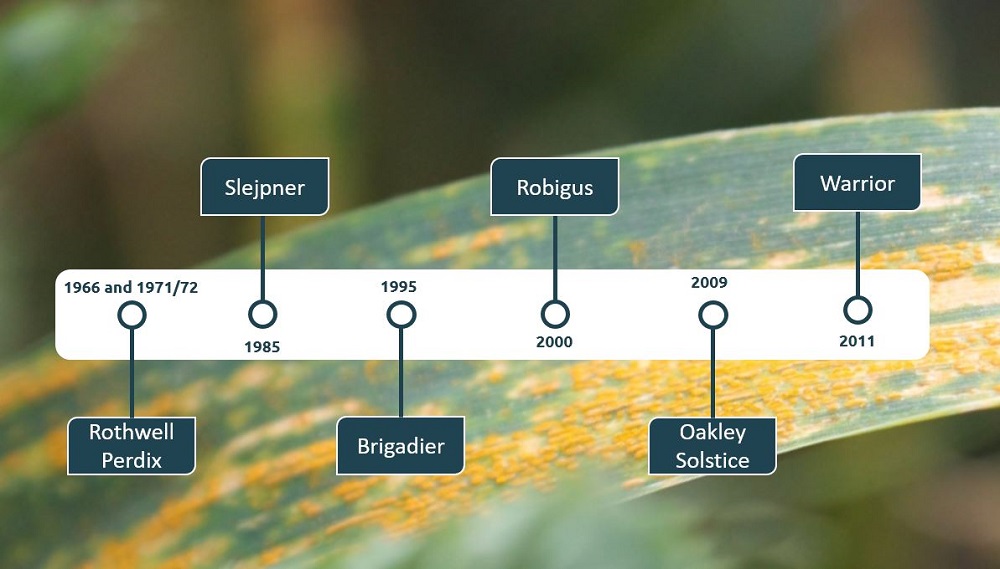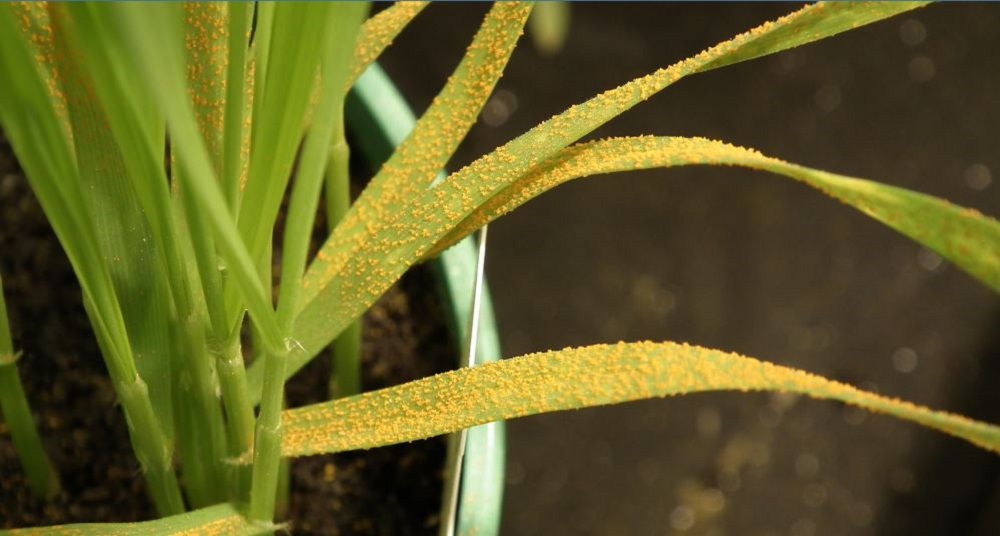Breeding wheat to beat yellow rust
Friday, 11 March 2022
Over the last decade, major changes to the UK’s yellow rust pathogen population have added complexity to the plant-breeding puzzle. Jason Pole, who leads on AHDB’s crop disease communications, outlines key points from a recent presentation on the topic.
Our UK Cereal Pathogen Virulence Survey (UKCPVS) project is essential to plant breeders, according to Rachel Goddard of plant breeding company Limagrain.
Rachel presented at a recent UKCPVS event (2 March 2022) and said that information, hard work, investment and time are required to ensure that winter wheat variety developments match the pace set by adaptable yellow rust populations.
The UKCPVS monitors cereal rusts and mildews. Through disease observations (phenotypic work) and analysis of pathogen genetics (pathogenomics), UKCPVS results help the plant-breeding pipeline deliver strong disease resistance to Recommended Lists (RL) varieties.
Yellow rust evolution
Rachel’s presentation centred on the challenges of breeding for yellow rust resistance.
Over the last 50 years, major breakdowns in yellow rust resistance have occurred relatively frequently (Figure 1) – in cycles of around 5 to 10 years.
When new pathogen variants arrive, they can spread rapidly (in just a few seasons).
 AHDB
AHDB
Figure 1. A timeline showing key years for wheat yellow rust population change in the UK
In 2011, the presence of the Warrior yellow rust race in the UK was confirmed. Compared to previous changes, Warrior was highly unusual for several reasons, including:
- It was derived from a sexual recombination (outside of Europe)
- It was first identified in many countries in the same year
- It caused yellow rust on many wheat varieties
- It was complex and varied
- Compared to the previous population, it was highly adaptable. It:
- Tolerated a greater range of temperatures
- Had a shorter time from infection to sporulation
- Produced a greater number of spores
- Developed black telia relatively late in the season
- Broke many resistance genes and gene combinations
In fact, Rachel said that post-Warrior “yellow rust was like a new disease”.
A major reason why Warrior affected so many varieties was because it unpicked a single, major adult plant resistance gene – YRClaire – one that had been extensively used in plant breeding since 1997.
The post-Warrior explosion in the diversity of the yellow rust population was so large it demanded a change to the way new variants were named. Today, new races are assigned to a genetic colour group and given a sequential number – unique to the varieties on which they cause disease (pathotype).
Since the incursion of Warrior, the red group of isolates has dominated the population – with it featuring over 50 pathotypes.
Frequencies of these pathotypes vary over time and space: even across a short distance in a field, the pathotypes present can vary substantially.
The three most dominant pathotypes represent around a third of the population, according to the most recent UKCPVS results.
Post-Warrior, the yellow rust population has changed so much that its ability to unlock resistance in some old varieties (from the 1990s) may have, in essence, been forgotten. This includes Brigadier (Figure 1), which features genes known to counter the Warrior population of races. Therefore, historic genetics may offer solutions for the varieties of tomorrow.
Plant breeding challenges
A major challenge for plant breeding is that a traditional wheat breeding cycle takes around 10 years. Despite early promise in pre-breeding and National Lists trials, varieties may no longer be resistant (or may be less resistant) by the time they reach RL trials.
However, UKCPVS pathotype information (presence and frequency) guides plant breeding efforts. The provision of representative pathotypes to breeders – for artificial infection (inoculation) of varieties in disease nurseries – also helps to maximise the chance of successful variety selection.
Disease nurseries are also used to evaluate resistance (R) gene combinations. There are at least eight R genes across the current set of RL winter wheat varieties. Wheat breeders look to incorporate (stack) as many effective R genes as possible to deliver durable disease resistance – providing any major yield penalties can be avoided.
Most RL winter wheat varieties have two or three R genes for yellow rust, and three have four. However, several only contain one R gene – not only increasing the vulnerability in these varieties, but to others too. Plant breeding companies, such as Limagrain, now aim to avoid deploying single R genes in commercial varieties.
There is a continual hunger to introduce new sources of resistance, as the elite wheat gene pool is narrow. Breeders turn to wheat’s wild relatives, direct ancestors, and landraces to help expand it. However, this route takes as much as three times longer than elite crosses due to the need to flush out undesirable traits.
Genetic technologies, such as marker-assisted selection, are helping to speed up the plant breeding process. Despite the changes to the yellow rust population, many RL varieties have strong resistance to the disease at the adult-plant and young-plant stages. It shows the ingenuity of plant breeders.
|
Adult plant disease rating |
Number of winter wheat varieties (RL 2022/23) |
|
8–9 |
22 |
|
6–7 |
9 |
|
5 or less |
7 |
Over half of winter wheat varieties resistant to yellow rust at the young-plant stage (news)
About the UKCPVS event
Targeted at breeders, crop scientists and technical agronomists, the annual UKCPVS stakeholder event features the latest project results. The 2022 event featured several related presentations and information on what the latest developments mean for control in the field this year.
 NIAB
NIAB



